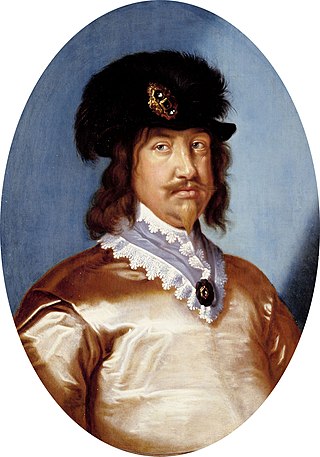| |||||
| Decades: | |||||
|---|---|---|---|---|---|
| See also: | Other events of 1627 List of years in Denmark | ||||
Events from the year 1627 in Denmark .
| |||||
| Decades: | |||||
|---|---|---|---|---|---|
| See also: | Other events of 1627 List of years in Denmark | ||||
Events from the year 1627 in Denmark .

Christian IV was King of Denmark and Norway and Duke of Holstein and Schleswig from 1588 until his death in 1648. His reign of 59 years and 330 days is the longest in Scandinavian history.

Glückstadt is a town in the Steinburg district of Schleswig-Holstein, Germany. It is located on the right bank of the Lower Elbe at the confluence of the small Rhin river, about 45 km (28 mi) northwest of Altona. Glückstadt is part of the Hamburg Metropolitan Region.

John the Younger or John of Denmark was the duke of Schleswig-Holstein-Sonderburg.

Danish India was the name given to the colonies of Denmark in the Indian subcontinent, forming part of the Danish overseas colonies. Denmark–Norway held colonial possessions in India for more than 200 years, including the town of Tharangambadi in present-day Tamil Nadu state, Serampore in present-day West Bengal, and the Nicobar Islands, currently part of India's union territory of the Andaman and Nicobar Islands. The Danish and Norwegian presence in India was of little significance to the major European powers as they presented neither a military nor a mercantile threat. Dano-Norwegian ventures in India, as elsewhere, were typically undercapitalised and never able to dominate or monopolise trade routes in the same way that British, French, and Portuguese ventures could.

The Treaty or Peace of Lübeck ended the Danish intervention in the Thirty Years' War. It was signed in Lübeck on 22 May 1629 by Albrecht von Wallenstein and Christian IV of Denmark, and on 7 June by Ferdinand II, Holy Roman Emperor. The Catholic League was formally included as a party. It restored to Denmark–Norway its pre-war territory at the cost of final disengagement from imperial affairs.
Margaret Stewart or Stuart may refer to:

The Duchy of Holstein was the northernmost state of the Holy Roman Empire, located in the present German state of Schleswig-Holstein. It originated when King Christian I of Denmark had his County of Holstein-Rendsburg elevated to a duchy by Emperor Frederick III in 1474. Members of the Danish House of Oldenburg ruled Holstein – jointly with the Duchy of Schleswig – for its entire existence.

The siege of Stralsund was a siege laid on Stralsund by Albrecht von Wallenstein's Imperial Army during the Thirty Years' War, from 13 May 1628 to 4 August 1628. Stralsund was aided by Denmark and Sweden, with considerable Scottish participation. The lifting of the siege ended Wallenstein's series of victories, and contributed to his downfall. The Swedish garrison in Stralsund was the first on German soil in history. The battle marked the de facto entrance of Sweden into the war.
Jens Munk was a Danish-Norwegian navigator and explorer. He entered into the service of King Christian IV of Denmark-Norway and is most noted for his attempts to find the Northwest Passage.

Kirsten Munk was a Danish noble, the second spouse of King Christian IV of Denmark, and mother to twelve of his children.
The Battle of Wolgast was an engagement in the Thirty Years' War, fought on 22 August (O.S.) or 2 September (N.S.) 1628 near Wolgast, Duchy of Pomerania, Germany.

Guðríður Símonardóttir was an Icelandic woman who was one of 242 people abducted from the Westman Islands, Iceland in 1627 in a raid by Barbary pirates. These raids came to be known as the Turkish abductions. After being held as a slave and concubine for nearly a decade, she was one of a few captives ransomed by the Danish king. She returned to Iceland, marrying the young theology student Hallgrímur Pétursson, who became known for his poetry and hymns.

The capitulation of Franzburg was a treaty providing for the capitulation of the Duchy of Pomerania to the forces of the Holy Roman Empire during the Thirty Years' War. It was signed on 10 November (O.S.) or 20 November (N.S.) 1627 by Bogislaw XIV, Duke of Pomerania and Hans Georg von Arnim, commander in chief of an occupation force belonging to the army of Ferdinand II, Holy Roman Emperor, led by Albrecht von Wallenstein. While the terms of the capitulation were unfavourable for the Duchy of Pomerania already, occupation became even more burdensome when the occupation force did not adhere to the restrictions outlined in Franzburg. Stralsund resisted with Danish, Swedish and Scottish support, another Danish intervention failed. Imperial occupation lasted until Swedish forces invaded in 1630, and subsequently cleared all of the Duchy of Pomerania of imperial forces until 1631.

Magdalene Sibylle of Prussia was an Electress of Saxony as the spouse of John George I, Elector of Saxony.

Christian was Prince-Elect of Denmark from 1610 and Heir Apparent to the Throne of the Kingdom of Norway from 1603. Dying in 1647, he was succeeded by his younger brother, Prince Frederick.

Pieter Isaacsz was a Danish court and portrait painter from Dutch origin who worked in a mannerist style on historical, biblical and mythological subjects. He was also a tapestry designer and art-dealer who spied for both the Netherlands, Denmark, and, eventually, for Sweden.

Jens Hermansson Juel was a Danish nobleman who served as Governor-general of Norway from 1618 to 1629.
Events from the 1590s in Denmark.

Christoffer Knudsson Urne of Årsmarke was a Danish statesman and landholder. He served as Royal Treasurer from 1617 to 1627, Governor-General of Norway from 1629 to 1642 and as Chancellor of the Realm from 1646.

Just Høg was a Danish statesman and landowner. He served as the first Hofmeister of Sorø Academy from 1629 to 1640 and then as Chancellor of the Realm from 1640 to 1646. He was the owner of Ghorslev Manor on Stevns.